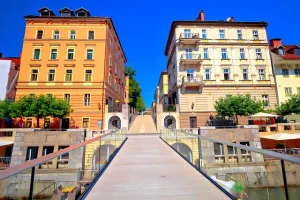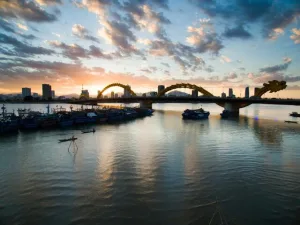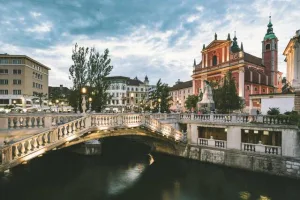Contents
- 1 Why should Ljubljana Slovenia be on your bucket list? Unlocking the Hidden Gems In 2024
- 1.1 Introduction
- 1.2 Ljubljana Slovenia
- 1.3 Historical Significance of Ljubljana Slovenia
- 1.4 How to Reach Ljubljana Slovenia
- 1.5 Best budget-friendly places to stay in Ljubljana Slovenia
- 1.6 Best time to visit Ljubljana Slovenia
- 1.7 Local Cuisine Of Ljubljana Slovenia
- 1.8 Must Visit Places In Ljubljana Slovenia
- 1.9 Activities to do in Ljubljana Slovenia
- 1.10 FAQs
 Why should Ljubljana Slovenia be on your bucket list? Unlocking the Hidden Gems In 2024
Why should Ljubljana Slovenia be on your bucket list? Unlocking the Hidden Gems In 2024
Introduction
In the world of globalization, we always care about what we have captured in our digital frames, which means the camera, and that is all about the good picture with the good landscape in the back or in the modern term, which is called the background of the picture. Now, it’s not about the debate about which country has the best landscape because every country has its beauty, culture, history, etc. It’s all about the travelling experience, and you will have those experiences when you travel to that country.
Whenever we travel, we always try to roam around European countries because we always find that the European continent has the most beautiful countries in the world. However, we never care about the small countries in Europe; they are always big nations. In this blog, we will cover a small country in middle Europe that is full of natural beauty and culture, Slovenia. Here, we will also make every single report of that country, including the stay, food, must-visit places, local cuisines, etc., for budget-friendly travellers and also for luxury travellers. So please stay connected with us till the end.
Ljubljana Slovenia
Slovenia is a small country in Central Europe, bordered by Italy, Austria, Hungary, Croatia, and the Adriatic Sea. This country is known for its hidden gem known for its stunning natural landscapes, charming towns, and rich cultural heritage. With its diverse terrain of mountains, lakes, and forests, Slovenia offers visitors an array of outdoor adventures and cultural experiences. It is a European Union, NATO, and the eurozone member.
Historical Significance of Ljubljana Slovenia

Ljubljana is Slovenia’s capital and largest city, with a history dating back to Roman times. The ancient history of this city is very rich, and it also played an essential role in the Slovenian national movement against fascism and communism. It was the seat of the dukes of Carniola, a Habsburg Empire province and later the Illyrian Provinces’ capital under Napoleon. It became the capital of independent Slovenia in 1991 after the breakup of Yugoslavia. This city has many museums, including the National Museum of Slovenia, displaying historic exhibitions, and the Museum of Modern Art, home to 20th-century Slovene paintings and sculptures.
How to Reach Ljubljana Slovenia
Ljubljana is easily accessible by various modes of transportation. Still, if you use the road, then it will be good for you because it will be cheap for you to travel from one European country to another on a Schengen visa. The primary air gateway of this country is Ljubljana Jože Pučnik Airport, which is located 26 kilometres from the city centre. It is connected by regular flights to many European destinations and some intercontinental ones. Ljubljana is also a railway hub, with direct trains to Vienna, Munich, Zagreb, Budapest, and other cities.
By road, Ljubljana is reachable by the A1 motorway from Italy and Austria, the A2 motorway from Hungary and Croatia, and the A3 motorway from the Adriatic coast. Ljubljana is also well-connected by bus, so you can easily enter from other neighboring countries.
Best budget-friendly places to stay in Ljubljana Slovenia

For budget travelers, Ljubljana offers a variety of accommodation options. Areas like the Old Town and Tabor are popular among budget travelers, offering convenient access to attractions and public transportation. Some of the best budget-friendly places to stay in Ljubljana are:
- Hostel Celica: A former prison converted into a unique hostel, with 20 cells as rooms, each decorated by a different artist. It also has a museum, a gallery, a bar, and a restaurant.
- Vila Veselova: A charming villa in the city centre, close to Tivoli Park and the main attractions. It has cosy rooms, a garden, a kitchen, and a lounge.
- Hotel Park: A modern hotel in the heart of Ljubljana, near the Dragon Bridge and the Ljubljanica River. It has comfortable rooms, a rooftop terrace, a bar, and a restaurant.
Best time to visit Ljubljana Slovenia
The best time to visit Ljubljana Slovenia depends on your preferences and interests. You can plan your trip accordingly based on the given information:
- If you like warm and sunny weather, then June, July, and August are the best months. But this time, you will get everything at expensive prices because this is the peak season to travel, so expect crowds and higher prices.
- If you prefer cooler and quieter weather, then April, May, September, and October are the best months. These are also the best months for seeing the spring flowers and the autumn colours. These months are still crowded, so if you are a budget traveller, then you can avoid this season.
- If you don’t mind the cold and the snow, then November, December, January, February, and March are the best months. The Christmas market and carnival are the best times to enjoy the winter festivities. But you must face extreme winter to be ready for that and the best months for budget travelers.
Local Cuisine Of Ljubljana Slovenia
Ljubljana Slovenia’s cuisine is influenced by the culinary traditions of Slovenia’s neighboring areas, including Italy, Austria, Hungary, and the Balkans. It uses seasonal and local ingredients such as meat, dairy, vegetables, fruits, and grains. Some of the local specialties of Ljubljana Slovenia are:
- Štruklji: A dish of rolled dough filled with various fillings, such as cottage cheese, walnuts, poppy seeds, or apples. It can be boiled, baked, or fried and served as a main course or a dessert.
- Kranjska klobasa: A smoked sausage made of pork, bacon, and garlic, seasoned with salt and pepper. It is usually grilled or boiled and served with sauerkraut, bread, and mustard.
- Potica: A festive cake made of yeast dough and various fillings, such as nuts, raisins, honey, chocolate, or tarragon. It is baked in a special round mould and served sliced or in rolls.
- Prekmurska gibanica: A layered pastry originating from the Prekmurje region near the Hungarian border. It consists of layers of dough, poppy seeds, cottage cheese, walnuts, and apples sprinkled with sugar and sour cream.
- Kraški pršut (Kras prosciutto): This is a dry-cured pork leg, similar to Italian prosciutto, but with a distinct flavour from the salt and the bora wind that dries the meat.
Must Visit Places In Ljubljana Slovenia

Some of the must-visit places of Ljubljana Slovenia are:
- Ljubljana Castle: A historic fortress on a hill overlooking the city, with a museum, a tower, and a panoramic view.
- Dragon Bridge: A famous bridge with four dragon statues, symbolizing the power and courage of the city.
- Triple Bridge: A unique bridge complex designed by the architect Jože Plečnik, connecting the old and new towns.

- Central Market: A lively market with stalls selling fresh produce, local delicacies, and handicrafts.
- Tivoli Park: A large and beautiful park with gardens, fountains, sculptures, and a cultural centre.
- Metelkova: A former military barracks became a cultural and artistic hub with colourful murals, galleries, and clubs.
- National Museum and National Gallery: The city’s two main museums showcase Slovenia’s history, art, and culture.
- Ljubljana Cathedral: A stunning baroque church with a dome, a fresco, and a pipe organ.
- Prešeren Square: The main square of the city, with a monument to the poet France Prešeren, a pink church, and a lively atmosphere.
- Ljubljanica River: The river that flows through the city, offering scenic views, boat tours, and riverside cafes.
Activities to do in Ljubljana Slovenia
Ljubljana is a vibrant and lively city with plenty of activities for all tastes and ages. Some of the activities to do in Ljubljana are:
- Explore the old town of Ljubljana, a picturesque area full of historical buildings, monuments, and squares.
- Ljubljana has a rich cultural scene, with many museums and galleries. You can learn about Slovenia’s history, art, culture, etc.
- Some museums and galleries are the National Museum, the National Gallery, the Museum of Modern Art, the City Museum, and the Metelkova Museum Quarter.
- Ljubljana offers a variety of tours and activities to help you discover the city and its surroundings. You can join the free walking tours, the bike tours, the boat tours, the food tours, and the wine tours.
- You can also take day trips to the nearby attractions, such as Lake Bled, Postojna Cave, Piran, and Škocjan Caves.
FAQs
1. Are credit cards widely accepted in Ljubljana Slovenia?
– Credit cards are widely accepted in Ljubljana, especially in larger establishments and tourist areas.
2. Is English widely spoken in Ljubljana Slovenia?
– English is widely spoken in Ljubljana, especially in tourist areas, hotels, and restaurants.
3. What is the currency used in Ljubljana Slovenia?
– The official currency of Slovenia is the Euro (EUR). ATMs are widely available in Ljubljana, allowing visitors to withdraw cash as needed.
4. Are there any outdoor activities available in Ljubljana Slovenia?
– Yes, Ljubljana offers a variety of outdoor activities, including hiking, cycling, and kayaking. Visitors can explore the nearby mountains, rivers, and parks, enjoying the region’s natural beauty.
5. What is the nightlife like in Ljubljana Slovenia?
– Ljubljana has a vibrant nightlife scene, with numerous bars, clubs, and live music venues. The city comes alive after dark, offering visitors plenty of options for entertainment and socializing.

 Why should Ljubljana Slovenia be on your bucket list? Unlocking the Hidden Gems In 2024
Why should Ljubljana Slovenia be on your bucket list? Unlocking the Hidden Gems In 2024 